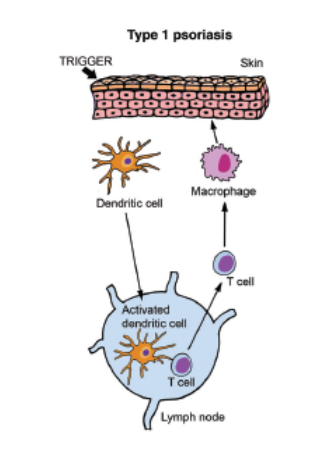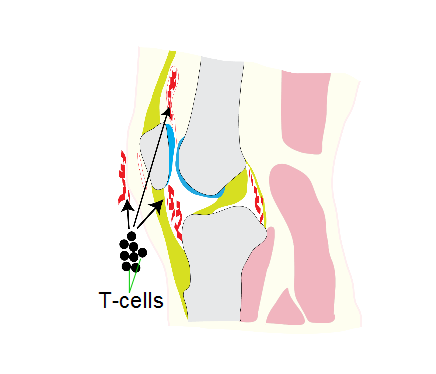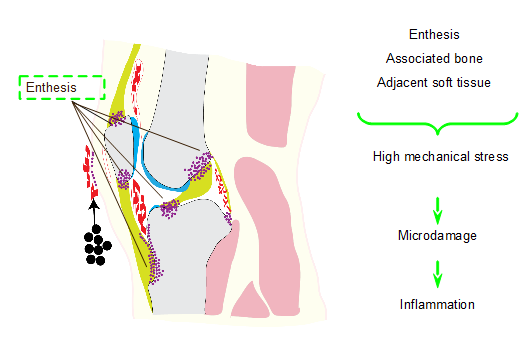The link between Psoriasis and Arthritis
Specialised cells of the immune system called T lymphocytes appear to play a key role in psoriasis.
This is especially the case in younger subjects with the extensive pattern of psoriasis known as Type 1 psoriasis.
A scheme for how T lymphocytes contribute to psoriasis is shown below.
 |
A injury or insult to the skin - a danger signal - triggers a local reaction. A specialised surveillance type cell called a dendritic cell picks up these signals. It goes back to the headquarters of the immune system or lymph glands. An interaction with soldier cells called T lymphocytes leads to the latter multiplying in number and becoming armed. These soldier cells go to the site of injury and directly contribute to inflammation or instruct other cells including scavenger cells called macrophages to participate in the process |
This scheme was applied to Psoriatic Arthritis also on the assumption that the same or related clones of T lymphocytes were also attaching the joint lining.
A historical scheme for this largely incorrect model for Psoriatic Arthritis is shown below.
 |
| The traditional model for Psoriatic Arthritis was that clones of these soldier cells or T lymphocytes not only attached the skin (red colour on left) but also the joint lining (other areas of red). This model assumed that a common structural element between both sites was being attacked. To date such a factor has not been found. Also, patients with psoriasis have lots of abnormalities at the enthesis and not the joint lining. |
However, the enthesis and not the joint lining appears to play the key role in the initiation of Psoriatic Arthritis.
It is thought that an abnormal response to joint stressing including microscopic damage or "microtrauma" may be key to arthritis development in Psoriasis.
 |
| The modern concept for arthritis in Psoriatic Arthritis is that the process starts off with inflammation at the enthesis and spreads to the joint lining. There is little evidence the date that the arthritis is dependent of soldier lymphocytes called T cells. For joint disease the problem may arise locally in the joint at sites of stress or damage (purple dots) rather than in the immune system headquarters in the lymph glands. |
According to this new theory that is supported by laboratory data, an abnormal response to injurious agents in the skin or joint triggers disease at these different sites.
However, it must be pointed out that the spectrum of inflammation in Psoriatic Arthritis is very broad and it is likely that T lymphocytes play a major role in some Psoriatic Arthritis variants.
